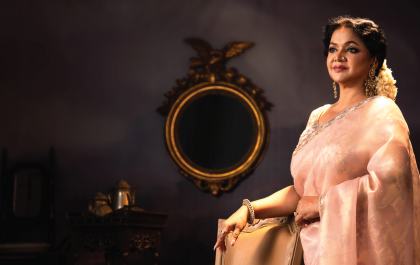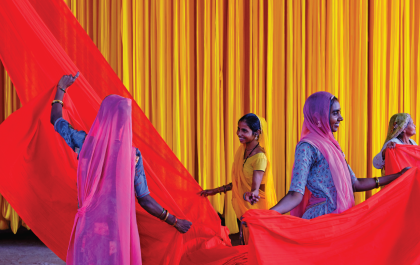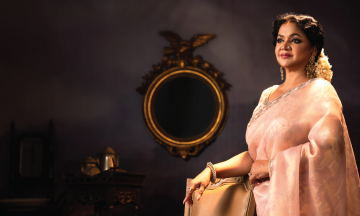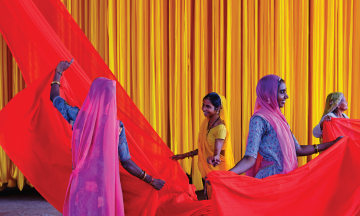From classroom dreams to global galleries: an intimate conversation with Kanak Chanpa Chakma, Bangladesh’s artistic icon and 2023 Ekushey Padak laureate
By Shams Nafiz
Kanak Chanpa Chakma – once a young dreamer captivated by sketches in schoolbooks, now a global art sensation and the esteemed recipient of the 2023 Ekushey Padak. I had the privilege to sit down with her over an Americano while we discussed her life, her art, and her passion. Join me as we discover the inspiration behind her evocative canvases and her role as a cultural steward in this exclusive interview.
Many artists have a moment when they realize art is their calling. Can you recall a specific incident from your childhood that solidified your decision to pursue art?
Ever since I was a toddler, before I could even string a sentence together, my fingers seemed to have a life of their own – they loved to draw. Give me chalk, a pen, a pencil, or even a chunk of charcoal, and I’d turn any surface into my canvas. As I went through school, my art wasn’t just doodles on the margins of notebooks; it started to win competitions and more than a few praises.
That’s when it clicked: this wasn’t just a hobby; it was a calling. Yet, fully embracing this path didn’t happen overnight. It wasn’t until I wrapped up my matric exams that I had a heart-to-heart with myself. I decided it was high time to take my passion from the sidelines to center stage.
When I broke the news to my parents, I received their support. My father helped me secure a spot at Charukola, an institution that would hone my skills and shape my future in art. Since then, there’s been no turning back – and I couldn’t be happier about it.

Your style is described as abstract impressionistic. Were there any particular experiences or influences, beyond Paul Gauguin, that helped shape this unique style?
Living in Rangamati wasn’t just an idyllic childhood – it was an everyday adventure in what could easily be called Bangladesh’s most enchanting landscape. Think shimmering waters set against the backdrop of mountains that touched the sky, all wrapped in a lush green tapestry. This wasn’t just scenery; it was the living, breathing essence of my community. And my community wasn’t just people; it was a way of life defined by our unique customs, our victories, and yes, our struggles too.
Each person, each experience became a brushstroke in my life’s painting. I grew up enveloped in the vibrant Bengali culture, rich in color, music, and traditions that have been passed down for generations. These traditions aren’t just history; they’re alive, they’re electric, and they’re a dynamic part of who we are today. Whenever I pick up a paintbrush, this cultural kaleidoscope whirls into action, giving life to each stroke, each color, each canvas.
And speaking of canvases, they are like my dialogue with the past and the present. I can’t forget the profound impact that artistic trailblazers like Paul Gauguin had on me, igniting my initial passion for art. Yet, I was equally stirred by the unique styles of Vincent Van Gogh’s swirling skies, Henri Matisse’s bold use of color, and the intimate lighting of Rembrandt’s portraits. These artists didn’t just create art; they redefined what art could be, stretching its boundaries and inviting us to see the world through different lenses. I’m eternally grateful to each one of them, for they expanded my own vision of what is possible on canvas.
So you see, whether it’s the natural splendor of Rangamati or the indelible impact of art legends, each influences me in a profoundly personal way. They all mingle in my thoughts, coming together to inform every piece I create. Through my art, I not only want to capture the beauty and challenges of my culture but also honor the revolutionary spirit of the artists who have shaped my own journey.

Given your profound bond with nature, how do you think modern urbanization and environmental changes have influenced contemporary art themes?
It’s a bit heartbreaking to see how our connection with nature is dwindling, especially among younger generations. I remember stepping into Dhaka for the first time in 1978; Dhanmondi was a green paradise – imagine it, lakes and forests, birds singing, and fresh air everywhere. Today, it’s a different story, choked by the pressures of urban sprawl and teeming populations. I always tell young people, including my own kids, to escape the concrete jungle whenever they can. Go hike a mountain, wade through a stream, or simply sit under a tree. It rejuvenates your spirit, and for artists, it’s like recharging your creative batteries.
Nature’s influence on art is not a one-way street, especially nowadays. You can see its impact taking two distinct directions in modern art. One is a sentimental look back, almost like we’re trying to paint or sculpt a perfect, untouched Eden that probably only ever existed in our imaginations. It’s art with a rosy tint, full of longing for simpler times. On the flip side, art is becoming a battle cry. Artists are turning activists, their pieces now loudspeakers that shout about climate change, endangered animals, and vanishing landscapes.
So yes, the mood has shifted. Once, art captured the serenity of nature; now it often captures its vulnerability. But one thing hasn’t changed: nature continues to be our muse. It still pulls at our soul, begging us to capture just a little bit of its magic on canvas or in clay. And as artists, we have a role that goes beyond mere representation. We need to be nature’s advocates. Our art should do more than just capture nature’s beauty; it should inspire everyone to stand up and protect this magnificent world we’re fortunate enough to call home.


How do you feel the art world responds to women artists, especially those focusing on feminist themes, both in Bangladesh and internationally?
Firstly, let’s get one thing straight: feminism in art isn’t just a “women’s issue.” Men are creating feminist art too, and I’m all for it. Now, speaking of women artists – yes, many of us are using our paintbrushes and chisels as tools for activism. The art world is gradually waking up to gender equality, but let’s not kid ourselves; there’s still a mountain to climb.
I recall my childhood days when women, despite their contributions, were side-lined during important family decisions. Take my mom, for example – a master weaver who even bagged national awards. Yet, she’d always step back, letting my dad take the lead. But oh, how times have changed! Today’s women in Bangladesh aren’t just demure wallflowers; they’re stepping up, speaking out, and leading the way.
Look at my art, and you’ll notice the spotlight is often on women – particularly the indigenous women from Chittagong Hill Tracts. I don’t just paint their hardships; I paint their triumphs, their resilience, and their untold stories. It’s not about showing them as delicate subjects in a pretty picture; it’s about underlining their equality, their rights, and their untapped potential. That’s why I tip my hat to every artist championing feminist themes. Women’s worlds are unique and rich, and it is high time we started respecting that.
So, as far as progress is concerned, yes, we’ve made some. But as long as women’s safety, dignity, and equal participation remain issues, we have work to do. And as artists, we have the power to contribute to this change.

Having discovered similarities between Bangladeshi indigenous groups and Native Americans, do you believe that there’s a universal indigenous spirit or narrative that binds all such communities worldwide?
Absolutely, let me take you on a journey. Back in 94, I landed in the US thanks to a fellowship program. The experience was eye-opening, to say the least. One of the unforgettable moments was in New Mexico, where I met Native Americans. We shared stories, admired their art, and even witnessed their sacred dances and rituals. It was as if an invisible thread connected us, transcending miles, cultures, and centuries.
Since that transformative trip, my art passport has gotten stamps from indigenous communities all over the map – from the icy landscapes of Norway to the bustling streets of India, and from the majestic mountains of Canada to China’s sprawling cities. I’ve had the honor of meeting tribes worldwide and showcasing their shared traits through my art. The response has been nothing short of awe-inspiring.
Over the years, I’ve come to appreciate art as a universal language – one that breaks down barriers, be they linguistic, cultural, or geographic. Art has the power to evoke emotions and spark conversations that words alone can’t. And that’s something I aim to delve even deeper into in my future projects.

Your involvement in social work is commendable. How do you balance your commitments to art and social causes? And how do these two worlds influence each other?
Thank you for recognizing the social aspects of my work. Painting isn’t just a job for me; it’s a sanctuary where I lose myself in a tapestry of colors. When I’m in my studio, I’m in a world of my own, a place where distractions cease to exist. Yet, the sanctuary expands beyond my easel. My art is my passport to understanding life from various angles – working with acid attack survivors, individuals from the third-gender community, autistic children, and marginalized women opens windows to worlds I might never have known otherwise.
It’s not just about humans; I also extend my compassion to our four-legged friends. I’ve opened my home to rescue animals, particularly during the tough times of the pandemic. The goal is not just to heal them but to rehabilitate and give them a new lease on life. The vulnerability of these beings serves as a stark reminder of the consequences of greed and malice in our society. All of these experiences weave themselves into my art, enriching its emotional texture.
Art and activism? To me, they’re inseparable, like two harmonious notes in a grand symphony. Each enriches the other, creating a loop of inspiration and action that continues to fuel my journey.
But my work doesn’t stop at the borders of my own opportunities. I’m deeply involved in uplifting our indigenous artists, giving them platforms and opportunities that I didn’t have growing up. Through workshops, camps, and exhibitions stretching from Bangladesh to India and Nepal, I aim to shine a spotlight on this untapped reservoir of talent.
So, what’s the secret sauce that lets me juggle all these balls? Passion. Pure, unadulterated passion. When you love what you do, the time finds you, the energy fuels you, and obstacles simply become milestones waiting to be crossed. In short, my art and my social activism are threads in the same tapestry, each adding richness and meaning to the other. And I believe this synergy shines through in my work, touching people on a level that’s much deeper than just the visual.

What guidance would you offer to young artists, especially those from indigenous backgrounds, hoping to make their mark in the art world?
I’ve got to say, the young artists of today really dazzle me. They’re braver, sharper, and hungrier for success than ever before. But if I could share some golden nuggets of wisdom for these rising stars, here they are:
- Be true to you: Your biggest treasure is your own unique viewpoint, shaped by your roots, your experiences, and your culture. Don’t water it down to blend into what you think is “popular art.” Realness has a way of striking a chord with people.
- Be a Sponge: Sure, talent is great, but crafting it is crucial. Never stop absorbing new techniques or ideas. Whether you’re in a formal art school, taking short courses, or simply learning by doing, keep sharpening those skills.
- Rub Elbows: Mix and mingle with a colorful palette of artists, mentors, and even critics. Show up at galleries, no matter how small. The art world is like a living organism, always growing through connections and teamwork.
- Listen to Echoes: Sometimes, you’re too attached to your work to see it clearly. That’s where a second (or third) set of eyes comes in. Listen to constructive feedback. Even if you don’t take every piece of advice, at least consider it.
- Be a Storyteller: You have stories buried inside you that the world has never heard. Let your art be the stage where these tales come to life. It doesn’t just make your work more relevant; it’s a nod to your culture’s richness.
- Toughen Up: Rejections? Criticisms? Flops? These aren’t stumbling blocks; they’re stepping stones. Grit is your best friend on this artistic journey. Every “no” is just a detour on the way to a bigger, better “yes.”
- Lend a Hand: If fortune smiles on you, smile back by giving to society. Whether it’s through teaching, activism, or even just giving advice, your rise should help others rise too.
- Follow Your Fire: At the end of the day, let your heart lead the way. Passion is your best compass. It’ll guide you through the hard times and make your masterpieces even more mesmerizing.
Embarking on an artistic journey is an act of courage and expression. Embrace it wholeheartedly, and don’t forget to enjoy the ride. Art is not just about the destination; it’s about the richness of the journey itself.
How would you like to be remembered in the annals of art history? And what future projects can art enthusiasts look forward to from you?
More than anything, I want to be known as someone who had a good heart, a spirit that reached beyond the canvas. My dream is to leave an indelible mark not just through my art but also through my impact on the community and society at large. I want my life’s journey – the grit, the hustle, the overcoming of obstacles – to serve as a living lesson for others.
“When the curtain closes on my life’s show, I hope I’m remembered as more than just an artist”
I aim for my artwork to be like a spotlight, illuminating the hidden stories of indigenous communities and the natural beauty of Bangladesh. But it’s not just about local landscapes; it’s about that deep, universal bond we all share with Mother Earth.
In a world that often sidelines the “little guy,” I strive to be a voice for the voiceless, a champion for those on the margins. Not just breaking through artistic boundaries, but shattering societal norms to lift up those who’ve been pushed down.
So when the curtain closes on my life’s show, I hope I’m remembered as more than just an artist. I want to be the change-maker who used every brushstroke and every action to advocate for the marginalized and underrepresented and make the world a bit more equitable, more understanding, and more beautiful.













